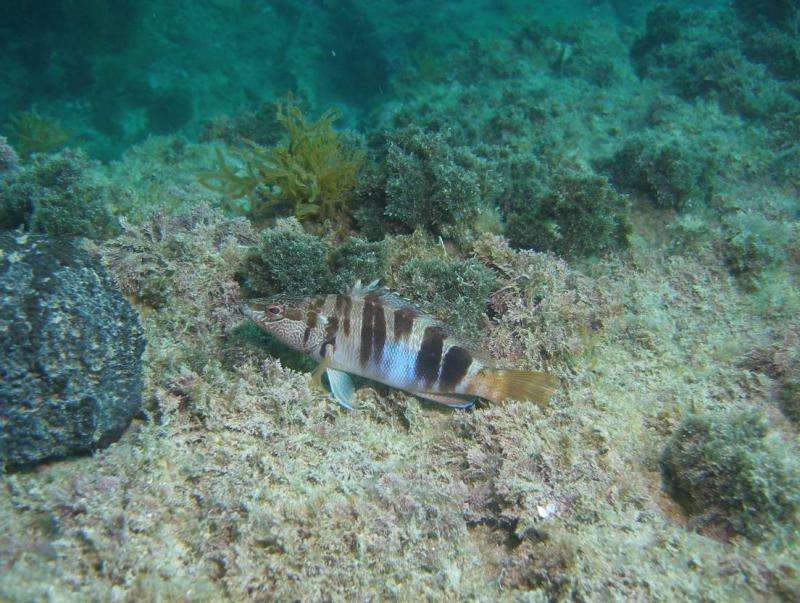Clever fish around the coast of Mallorca Island

To avoid overfishing and aid in sustainable exploitation, the status of the fish stocks has to be monitored regularly. In many cases stock assessment is based on fishery-dependent data generated from fish markets or creel surveys. The assumption is: the lower the catches in a certain unit of time, the smaller the stock of fish should be. The scientists Dr. Josep Alós and Prof. Dr. Robert Arlinghaus from the German Leibniz-Institute of Freshwater Ecology and Inland Fisheries and the Humboldt-Universität zu Berlin have now shown that some fish species show enhanced gear-avoidance behaviour in regions with high angling intensity compared to fish exposed to low levels of exploitation near marine protected areas. The consequence is the impression that there are less fish in the sea, which does not necessarily agree with underwater reality.
The coast of the Spanish Island Mallorca is a holiday paradise for sun worshippers and for those loving water sports. But few are aware of the exiting phenomena that happen below the water surface. Here, a competition between increasingly clever fishes and the catch-addicted fishers takes place. Within a project funded by the European Union, the Spanish scientist Josep Alós and the German-Spanish scientist Robert Arlinghaus from the German Leibniz-Institute of Freshwater Ecology and Inland Fisheries and the Humboldt-Universität zu Berlin have investigated the fish populations at the coast of Mallorca using novel mathematical models and monitoring methods . Their research aims at understanding the behaviour of fish in response to recreational fisheries. Based on standardized angling catch methods in a study from 2013 the scientists concluded that marine protected areas host higher fish quantities and bigger fishes than sites with a high exploitation pressure. A follow-up study now released in the Canadian Journal of Aquatic Sciences, which used underwater video analysis in addition to angling as a method to quantify the fish stock, puts these former results into doubt. The reason for this: clever fishes that escape the pursuit of the anglers without a corresponding decline in fish stock levels.
More anglers means less painted comber on the hook

The research team investigated two fish species popular among recreational anglers along the Mediterranean Sea. Both have the same size and the same habitat but differ in their eating habits. The painted comber (Serranus scriba) show a carnivorous foraging mode and feeds on fish and small crustaceans while the annular seabream (Diplodus annularis) lives on mobile algae and bivalves. The seabream can afford to carefully examine the potential prey and takes its time moving around the baits, inspecting them and is generally less vulnerable to capture in comparison with the comber. By contrast, the comber evolved a carnivorous life-style: too much hesitation and the mobile prey is gone. As a result of this, the painted comber is much more aggressive towards baits than the annular seabream in their natural habitats where fishing pressure is low, which makes the comber much more vulnerable to be harvested by the anglers.
The recent study by the researchers has now shown a starkly different behaviour in sites where the fishing pressures is high. The researchers studied the behavioural responses towards baits in 54 different locations with the same habitat characteristics but different angling pressures. An autonomous underwater video recording was used to measure the behaviour of the fish when they were exposed to baited hooks.
The researchers were amazed when finding a strong correlation between high fishing intensity and hook-avoidance behaviour of painted comber: this species had starkly changed the behaviour from aggressively attacking the baited hooks in the natural environments with low fishing pressure to being shy in exploited sites where they were able to recognize the fishing gear and avoid hooking. No such response was detected in the seabream. The explanation may involve both genetic change towards increased shyness and learning to avoid future capture.
Discover the latest in science, tech, and space with over 100,000 subscribers who rely on Phys.org for daily insights. Sign up for our free newsletter and get updates on breakthroughs, innovations, and research that matter—daily or weekly.
Less fish on the hooks does not necessarily mean less fish in the sea
Although the catch rates of comber in areas with high fishing intensity were half of those in low exploited and marine protected areas both sites showed similar fish densities as recorded by underwater video. Therefore, the benefits of marine protected areas previously determined by the same authors in 2013 were not supported by underwater video footage now. "These results suggest that recreational angling may contribute to patterns of hyper depletion in catch rates without a corresponding change in the fish population where catch rates declines stronger than the abundance of fishes", the first author of the study, Josep Alós, comments. And further: "Reports on the dramatic decline of fish populations in the ocean which were only based on fishery-dependent data, for example data from the long-line fishery of tuna, cod or swordfish, could also have their cause in enhanced gear-avoidance behaviour of those fishes. We have to rethink our monitoring of fish stocks and take the behavioural changes into account. Maybe some areas with high fishing intensity host more fish than we believe", concludes study leader Robert Arlinghaus.
More information: "Impacts of partial marine protected areas on coastal fish communities exploited by recreational angling," Fisheries Research, Volume 137, January 2013, Pages 88-96, ISSN 0165-7836, dx.doi.org/10.1016/j.fishres.2012.09.007
"Recreational angling intensity correlates with alteration of vulnerability to fishing in a carnivorous coastal fish species." Canadian Journal of Fisheries and Aquatic Sciences, 2015, 72(2): 217-225, DOI: 10.1139/cjfas-2014-0183
Journal information: Fisheries Research , Canadian Journal of Fisheries and Aquatic Sciences
Provided by Forschungsverbund Berlin e.V. (FVB)

















